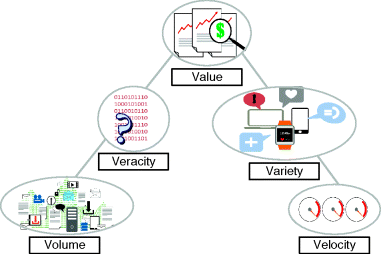Chapter 9Understanding the Components of the Technical Plan: Big Data
How Big Data Helps Deliver Better Outcomes
In the beginning of the book, I discussed the changes in the volume and types of data companies now have access to. This new unstructured data represents a powerful untapped resource. With the joy of more data has come the pain of finding solutions that can turn this tsunami of data into useful information. In this chapter, I discuss how big data and the four Vs (volume, variety, velocity, and veracity) are changing the types of tools that IT and line-of-business managers have access to for gathering insight.
IBM and others have coined a fifth V, for value (see Figure 9.1). I'll discuss each of the Vs in further detail in a moment. Similar to the last chapter, the following pages will provide a basic outline of the opportunities, challenges, and things business leaders must understand to effectively work with their technology teams and, most importantly, extract value from big data efforts.

Figure 9.1 The 5 Vs of Big Data
Let's take a moment to define big data in its broadest terms. Edd Dumbill, principal analyst for O'Reilly Radar and author of Planning for Big Data, defines big data as “data that exceeds the processing capacity of conventional database systems. The data is too big, moves too fast, or doesn't fit the structures of your database architectures. To ...
Get Right-Time Experiences: Driving Revenue with Mobile and Big Data now with the O’Reilly learning platform.
O’Reilly members experience books, live events, courses curated by job role, and more from O’Reilly and nearly 200 top publishers.

